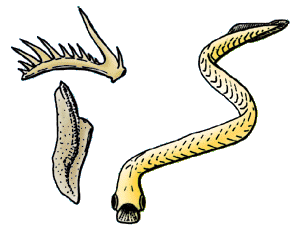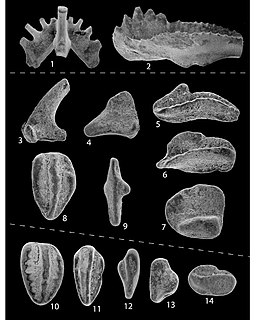
Conodonts are extinct agnathan chordates resembling eels, classified in the class Conodonta. For many years, they were known only from tooth-like microfossils found in isolation and now called conodont elements. Knowledge about soft tissues remains limited. The animals are also called Conodontophora to avoid ambiguity.
Hindeodus is an extinct genus of conodonts in the family Anchignathodontidae. The generic name Hindeodus is a tribute to George Jennings Hinde.
Prioniodontida, also known as the "complex conodonts", is a large clade of conodonts that includes two major evolutionary grades; the Prioniodinina and the Ozarkodinina. It includes many of the more famous conodonts, such as the giant ordovician Promissum (Prioniodinina) from the Soom Shale and the Carboniferous specimens from the Granton Shrimp bed (Ozarkodinina). They are euconodonts, in that their elements are composed of two layers; the crown and the basal body, and are assumed to be a clade.
Maurice Goldsmith Mehl was an American paleontologist. A longtime professor in the Department of Geology at the University of Missouri, Mehl was a founding member and officer of the American Association of Petroleum Geologists. Mehl was a fellow of the Geological Society of America (1922), the Paleontological Society, and the American Association for the Advancement of Science.
Doliognathus is an extinct genus of conodonts in the family Bactrognathidae from the Middle Dinantian. It is a genus of multielement conodonts.
Staurognathus is an extinct genus of conodonts in the family Bactrognathidae from the Middle Dinantian. It is a genus of multielement conodonts.
Edward B. Branson was an American geologist and paleontologist. He worked at the University of Missouri.
Ozarkodinida is an extinct conodont order. It is part of the clade Prioniodontida, also known as the "complex conodonts". There are two suborders of Ozarkodinida : Prioniodinina and Ozarkodinina.
Ozarkodina is an extinct genus of conodonts in the family Spathognathodontidae.

Polygnathus is an extinct genus of conodonts.
Palmatolepis is an extinct conodont genus in the family Palmatolepidae. It was the most abundant genus of conodonts of the Late Devonian, disappearing during the Devonian/Carboniferous crisis.
Spathognathodus is an extinct conodont genus in the family Spathognathodontidae. It is a non Platform conodont, from the Pennsylvanian (Caboniferous).
Acodus is an extinct genus of conodonts.
Idiognathodus is an extinct conodont genus in the family Idiognathodontidae.
Icriodus is an extinct conodont genus in the family Gnathodontidae.
Epigondolella is an extinct genus of conodonts in the family Gondolellidae.
Dollymae is an extinct genus of conodonts.



